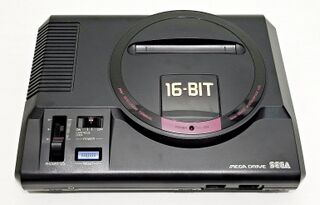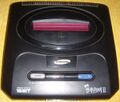Andlabs/Sega Mega Drive
From Sega Retro
- This rewrite is under active development and will replace the original page once complete.

|
| Andlabs/Sega Mega Drive |
|---|
| Manufacturer: Sega |
| Variants: Mega Drive 2, Genesis 3, Sega Mega Jet, Sega Nomad, Sega Teradrive |
| Add-ons: Sega CD, 32X, Power Base Converter, Super Magic Drive |
The Sega Mega Drive, called Sega Genesis in the United States due to trademark issues and Super Aladdin Boy in South Korea, is a video game console developed by Sega in 1988 in an attempt to take back its losses in the home gaming market from Nintendo by creating a home console to provide a closer arcade experience at home. Arcade hardware manufacturers had been creating games with more complex visuals and soundscapes than the Nintendo Entertainment System could provide, and Sega saw an opportunity for success — using scaled down versions of commonplace arcade components that would fit more easily in a consumer's budget and building on its existing Master System hardware to make manufacturing cheap (consequently, the Mega Drive can run in Master System mode, and various cartridge converters were made).
It was first released in Japan on October 29, 1988 with two launch titles, Space Harrier II and Super Thunder Blade, and retailing at ¥21,000. International releases would come over the next few years. The early game library and marketing campaigns focused on the arcade-at-home stance, and the Mega Drive found itself following the trends of arcade games at the time — shoot-'em-ups.
Consumers quickly became weary of the constant stream of arcade ports, and over time, game developers started putting different games on the Mega Drive — from RPGs like Sword of Vermilion and Shining in the Darkness to strategy games like Super Daisenryaku (the first third-party game in Japan) and Herzog Zwei (generally referred to as the first real-time strategy) to platformers like Castle of Illusion Starring Mickey Mouse and so on. Electronic Arts's support as a third party developer furthered this distancing, as EA's catalog, stemming from their history as computer game publishers, was much more diverse, primarily focusing on sports games. The release of Sonic the Hedgehog in 1991 finished this distancing, as developers scrambled to compete with Sega's new success.
Sega also played the console add-on game with the Sega Mega CD, which impressed gamers in Japan with a rich variety of games, however overseas, marketing focused on "full motion video" games that continuously failed to impress.
Nevertheless, games from all genres continued rolling in through to 1995. The Sega Saturn was already out in Japan and newcomer Sony was ready to tout its new PlayStation as the future. The success of the Super Nintendo Entertainment System had started to increasingly steal Sega's thunder from 1991. Third-party support for the Mega Drive disintegrated as the newer consoles and the improved capabilities of the Mega Drive's competitors wooed developers away. Finally, in a combination of poor communication between Sega of America and Sega of Japan and the desire to keep the Mega Drive afloat, Sega of America released the Sega 32X, an add-on which added its own additional capabilities to the Mega Drive, such as a larger color gamut. The 32X was released too late, had manufacturing errors at launch, and was too expensive to impress, and promptly fell flat on its face.
The Mega Drive died in Japan in 1995, with Sega releasing its last first-party game in Decenber and Compile releasing the last third-party game the following year. However, Sega contracted Majesco to continue manufacturing Mega Drives in the US and Europe through 1998, and the few third party developers and first party studios that stayed on board produced games like Vectorman 2 and Sonic 3D: Flickies' Island and many compilations. In an ironic twist of fate, a straight port of Frogger would be the last officially released Mega Drive game.
Official Variants
Mega Drive 1
Mega Drive 2
Hardware
- Main CPU: Motorola 68000 running at 7.67MHz NTSC/7.61MHz PAL
- The 68000 has a 24-bit address space, allowing access to up to 16MB of memory. Sega's memory map for the Mega Drive allowed games to be up to 4MB without the use of a memory mapper; games that tried to go up to 10MB would find their memory maps crushed by the Sega CD (which took the second 4MB block) and Sega 32X (which took 2MB of the third 4MB block). All devices are memory mapped.
- Main RAM: 64KB (repeated over the upper 2MB of address space)
- Graphics: "Video Display Processor," or "VDP:" modified Texas Instruments TMS9918 based on the modifications made for the Master System; all TMS9918 modes were removed and replaced with several new modes.
- Screen resolutions: 320x224, 256x224, 320x240 (PAL only), 256x240 (PAL only)
- "Interlaced mode" doubles the height of all four; it was used by some games, such as Sonic 2 for two-player mode
- Four graphics layers: two tile planes (just a grid of tiles), a "window" tile plane (cannot be transparent), and a sprite plane
- 64KB internal VRAM — used to store graphics tiles, mappings for all layers, and horizontal scrolling
- 64 9-bit words of internal CRAM — used to store the color palette
- 64 colors split into four 16-color lines; each tile can be drawn with one of these four color lines
- The first color in each line is transparent; consequently the Mega Drive can display 60 colors on screen at once
- Colors are 9-bit RGB with 3 bits per color component, allowing for 512 colors
- When writing CRAM values to the VDP, however, they are word adjusted to 16 bits
- Shadow/Highlight modes increase color gamut
- 80 bytes internal VSRAM — used for vertical scrolling
- Sound:
- Sound CPU: Zilog Z80 running at 3.58MHz NTSC/3.55MHz PAL
- Some games did not use the Z80, other games used it only for sample playback, but most used it for sound processing
- 8KB program RAM which the 68000 and the Z80 can freely write to (though the 68000 must request the Z80 bus)
- Can access 32KB of the cartridge at once
- Yamaha YM2612 clocked at the 68000 clock speed
- 6 channels of FM synthesis, Operator Type-N
- The third channel can enter a Special Mode, or multifrequency mode, where each individual operator has a different frequency
- The sixth channel can enter a DAC mode where the sound program constantly streams 8-bit unsigned PCM data to mix directly into the output waveform
- Mapped to the Z80 address space — 68000 must request the Z80 bus to use
- Texas Instruments SN76489 clocked at the Z80 clock speed and built into the VDP — same as with the Master System
- Three channels of pure square tones and one noise channel
- The noise channel can play either white noise or "periodic noise" either at one of three preset frequencies or using the frequency of the third tone channel (consequently, that channel will be mute)
- Can be freely accessed by both the 68000 through the VDP and the Z80 through its memory map
- The cartridge connector has two pins which allow stereo sound mixing directly from cart. No game used this, however the 32X uses it for its PWM audio.
- The Mega Drive 1 has mono audio output from the TV output and stereo output from a built-in headphone jack, plus a built-in volume control. Future models drop the headphone jack and do stereo output from the TV output
- Sound CPU: Zilog Z80 running at 3.58MHz NTSC/3.55MHz PAL
- Controller input: Two male DE-9 controller ports; one female DE-9 expansion port (early MD1s only)
- Controller ports support two modes: parallel and serial
- Parallel supports 7-bit bidirectional, with the console setting the direction of each bit.
- Parallel also supports optional active-low interrupts on the TH line. (mapped to 68000 IRQ 2)
- Serial mode supports up to 4800 bps. (used by the Mega Modem on port 3)
- Expansion port: Used for Sega CD.
- Provides access to /FDC ($A120xx) and /DISK to indicate Sega CD presence.
- Maps Sega CD PRG RAM to $000000-$020000.
Gallery
- Asian md2 box inside.jpg
Later Asian Mega Drive 2 box (inside)














